What is Wrack?
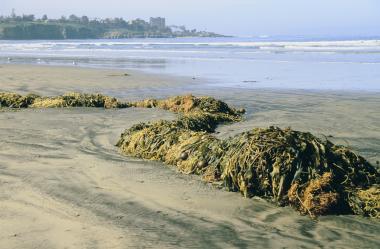
“Wrack” is the term for seaweed, surfgrass, driftwood, and other organic materials produced by coastal ecosystems that wash ashore on the beach. In Southern California, giant kelp is an important component of wrack. Coastal storm waves tear giant kelp off the rocky seafloor and wash it ashore where it fuels the beach food web. Piles of slippery wrack are delicious buffets and key food resources for many creatures that live on the beach.
Who's in the Wrack?
Wrack provides food and shelter for a variety of beach inhabitants. Recently, biologists found that about 40% of the invertebrate species living on sandy beaches depend on wrack. Common wrack-dependent species include sand-dwelling invertebrates, such as beach hoppers, roly polies, kelp flies, and predatory rove beetles. These little creatures are also food for a variety of birds including shorebirds, flycatchers, sparrows and pipits.
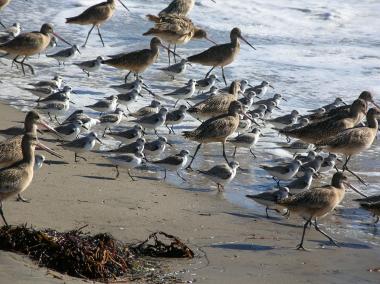
Shorebirds
Many shorebirds feast on the abundant invertebrate animals associated with kelp wrack, including snowy plovers, black-bellied plovers, sanderlings, marbled godwits, whimbrels, and willets.

Kelp
While all sorts of other organic material can be deposited as wrack, kelps (such as giant kelp and boa kelp) tend to make up the bulk of wrack on California beaches. Kelps are a type of brown macroalgae, and as photosynthesizing organisms, they fulfill the same role as plants on land. Kelps are part of the base of the marine food chain and are food sources for many organisms including many of the critters that inhabit sandy beaches.

Kelp fly (Diptera)
Kelp flies are found on temperate shores worldwide and are closely associated with kelp wrack. Female flies lay their eggs in the wrack, and the fly larvae feed upon the kelp after hatching. The flies are an important food source for shorebirds, such as plovers and sandpipers. A number of terrestrial birds, including swallows, flycatchers, sparrows and pipits, feed on kelp flies too.
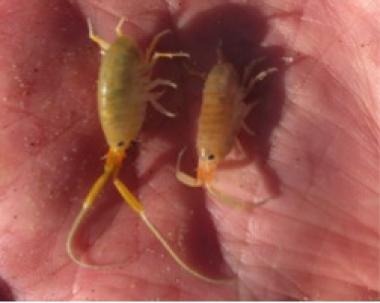
Beach hoppers (Amphipods)
If you turn over a clump of kelp wrack, you might notice a flurry of shrimp-like animals jumping away. These critters are called beach hoppers, and they are a type of crustacean called amphipods. Beach hoppers feed upon kelp wrack at night and burrow underneath it for shelter in the daytime. Like kelp flies, these beach hoppers are an important food source for many shorebirds.
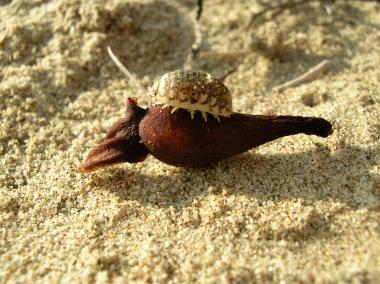
Roly polies (Isopods)
Beach roly polies are very similar to amphipods – both are small, segmented crustaceans that feed upon kelp wrack on sandy beaches. Learn more about roly polies and how they can signal beach health.
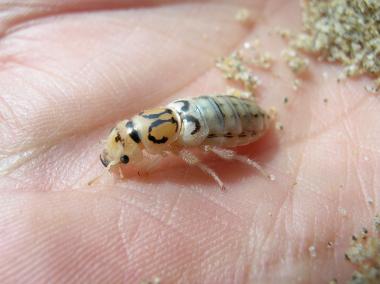
Rove beetle (Coleoptera)
Rove beetles live in temporary burrows in the damp sand and under wrack, emerging at night to prey upon beach hoppers and other insects. Some of the biggest rove beetles on the beach are flightless. Certain species feed mainly on flies.
Why is Wrack Important?
Wrack provides an important ecological link between the land and the sea. No plants or seaweeds can grow in the unstable, wave-washed sand of the beach; so, beach animals rely largely upon sources of food, like wrack, that drift onto shore from other ecosystems. Wrack feeds many creatures that live on and in the sand, and these creatures in turn provide a food source for other animals such as birds. In essence, wrack provides one of the two major foundations of the sandy beach food web. The other is plankton, which feeds all the lower beach suspension feeders, enhancing the biodiversity and abundance of life along the coastline.
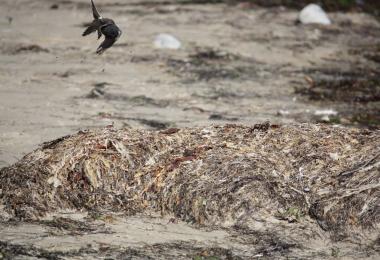
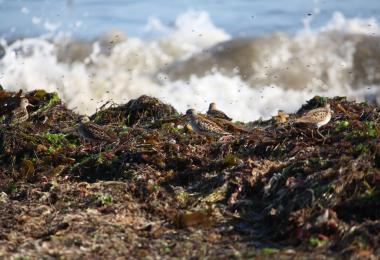
Wrack decomposes over time releasing essential nutrients into the beach and acting as rich fertilizer for surrounding ecosystems. One study found that land plants near wrack grow 70% faster than plants without wrack nearby. Another study found that decomposing wrack also provides nutrients for surfgrass and other plants that grow just offshore in the shallows.
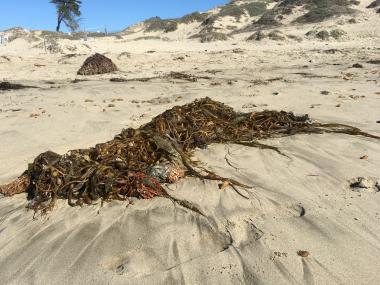
Wrack can help anchor dunes by trapping and storing windborne sand, creating hummocks and dunes, and providing the structure needed for land plants to take root and grow on the upper portions of the beach. These dunes not only support a unique community of plants and animals, they also act as natural barriers to large waves and storm surge. Wrack is instrumental protecting coastal communities from flooding.
Threats to Wrack

Wrack is often cleared away from public beaches in a process called beach grooming. While grooming provides flat, clean expanses of sand for recreation, it also removes all the benefits that wrack provides to the beach ecosystem. Species like beach hoppers and roly polies decline dramatically along with the shorebirds that prey upon them. Removing wrack also causes the number of hummocks and dunes to decline along with the amount of dune-based plants. Explore an interactive map with examples of groomed and natural beaches in Southern California.
Wrack and Climate Change
Wrack may help sandy beach ecosystems combat climate change. Sea-level rise is expected to reduce the width of sandy beaches and increase erosion. Wrack can help counteract this process since it traps windblown sand and promotes the formation of protective coastal dunes.
Climate change may alter how much kelp grows offshore, the energy in waves, and the shape of beaches. All of these factors will combine in complex ways to affect how much wrack is deposited on the beach. Therefore, beach managers can monitor what happens on their local beaches and support scientific studies to estimate how amounts of wrack will change in the future.
Implications for Beach Management and Planning
Beach managers' decisions about wrack affect beach ecosystem health and resilience. Managers can protect and enhance the diversity of creatures associated with wrack by strategically limiting beach grooming. Planners may limit the amount of hard development inland from sandy beaches to give beaches space to migrate inland as sea levels rise. This maintains space for habitat and human recreation.
Quick Facts
- Wrack is mostly made up of seaweed (i.e. kelp) and surfgrass.
- No plants or seaweeds can grow in the unstable, wave-washed sand of the beach. As a result, beach animals rely largely upon sources of food, like seaweed wrack, that drift onto shore from other ecosystems.
- Wrack supports an entire food web of beach critters including beach hoppers, roly polies, flies, and predatory rove beetles, as well as snowy plovers and other shorebirds.
- 40% of the invertebrate animal species living on sandy beaches depend on wrack!
- When wrack decomposes, it becomes rich fertilizer for surrounding ecosystems.
- Piles of wrack trap and store sand helping dunes form. Dunes can protect coastal communities from flooding, especially during storms.
- While beach grooming provides flat, clean expanses of sand for recreation, it also removes all the benefits that wrack can provide to a beach ecosystem.
- Climate change may alter how much kelp grows offshore, the energy in waves, and the shape of beaches and, consequently, the amount of wrack deposited on the beach.


